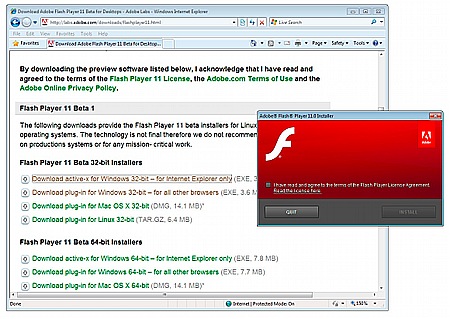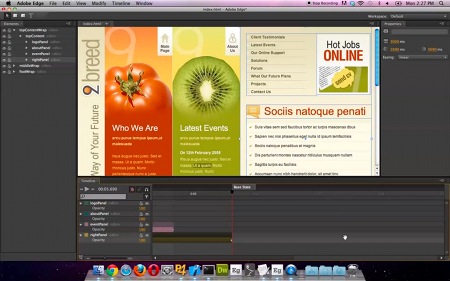Flash and HTML5 can move forward together, Adobe claims
Oct 5, 2011 — by LinuxDevices Staff — from the LinuxDevices Archive — 7 viewsAt its MAX 2011 conference in Los Angeles, Adobe Systems revealed some of its strategy for taking its flagship Flash Platform forward while also enabling developers to build rich applications using HTML5. The company is not abandoning Flash for HTML5, nor is it putting one ahead of the other, officials emphasized.
Indeed, during the second day keynote at the Adobe MAX 2011 developer conference here, the company laid out several instances of how Adobe Flash technology and HTML work together to deliver highly expressive experiences in the browser and as apps.

Installing Flash Player 11
(Click to enlarge)
Danny Winokur, a vice president and general manager at Adobe spoke of how Flash and HTML5 development go hand-in-hand. And he indicated that Flash Player 11 (above), along with Adobe AIR 3, will bring even more power and better experiences to users and developers.
Meanwhile, Adobe also is acquiring Nitobi, the maker of PhoneGap, a popular web framework using HTML5, JavaScript and CSS to build cross-platform mobile apps for all major mobile platforms. During the Adobe MAX day two keynote, Andre Charland, co-founder and CEO of Nitobi, joined Ben Forta, Adobe's director of evangelism, to announce that the PhoneGap Build tools will be available on the Adobe Creative Cloud platform the company announced at the opening of MAX.
Moreover, Charland said when working with PhoneGap developers can use any IDE [integrated development environment] you want — Eclipse, Visual Studio, Dreamweaver. Most people who are building web apps can extend that to the phone with PhoneGap."
Winokur also announced that Adobe Edge Preview 3 is now available, adding new interactivity features like looping, hyperlinks, and animation control. It also has a new built-in code snippet library and the ability to add custom JavaScript. Expand the boundaries of motion and interaction design using HTML5, CSS3, and JavaScript.

Adobe's Edge
(Click to enlarge)
Adobe Edge (above) is an HTML5 motion and interaction design tool that is bringing Flash-like animation to websites and mobile apps using the latest capabilities of HTML, JavaScript and CSS. Adobe says the new release contains innovative interactivity features and other additions suggested by the development community, and enables content creators to easily deliver a new level of visual richness to HTML5-only websites and mobile apps.
Adobe has also extended existing tools like Adobe Dreamweaver and Flash Professional to bring the next generation of web standards to designers and developers who rely on those tools. Adobe also released the new CSS3 Mobile Pack for Adobe Fireworks, which will enable designers to easily extract CSS3 from their design elements in Fireworks and quickly add them to their HTML based websites and mobile applications.
Meanwhile, Adobe announced several HTML contributions. The company has been contributing actively to HTML5 with the W3C and through contributions to Webkit to enable new expressiveness in HTML.
The Adobe contributions include CSS Regions. CSS Regions give designers more control over the flow of text in HTML by letting them wrap text around graphics and custom shapes. CSS Regions are available in the latest versions of Chromium and Internet Explorer 10.
Adobe also has contributed CSS Shaders. Adobe has proposed CSS Shaders to the W3C as a contribution to HTML, with the goal of enabling rich, animated effects for the HTML5 content elements through CSS. CSS Shaders is based on Adobe's Pixel bender technology. However, the CSS Shaders submission to the W3C was co-edited by Opera and Apple, Adobe officials said.
"We've been able to advance Flash and gather learnings from Flash Player being available on 98 percent of computers, and then take those learnings and bring them back into HTML and into the standards," Winokur said in a Q&A session with press and analysts.
"Pixel Bender is a great example of where we've already done that," he added. "We had a pioneering technology in Flash and then we leveraged the learnings that we got and used that as the basis for the work that we contributed to the W3C for CSS Shaders. We're going to continue to do that."
The new releases of Adobe Flash Player 11 and Adobe AIR 3 enable immersive application experiences for gaming, rich media, and data-driven apps. And native extensions for Adobe AIR provide developers with easy access to device-specific libraries and features, says Adobe. (AIR is available for Android, but no longer available for desktop Linux users.)
"I like native extensions a lot in AIR 3," said RJ Owen, a senior software architect at EffectiveUI, in an interview with eWEEK. "I like having the ability to customize your code. Flash is good at the visual layer. It's awesome at that, but if I want to do image processing on a phone, which is already low power, I want to do that in native code and be as efficient as I can."
Jesse Redniss, vice president of digital strategy and development at cable TV's USA Network, said, "We build with Flash and AIR because it provides us ease of development process on one platform, and also ease of cost and ease of development timeline."
New tools will target future platforms
Meanwhile, Paul Gubbay, vice president of Web and Interactive at Adobe, said to do great web development you need three things: Great browsers, great frameworks and great tools. Regarding the tooling, Gubbay announced the pre-release versions of Flex 4.6 and Flash Builder 4.6, which will provide new components, access to the latest platform and device capabilities, and native install experiences.
The company said its tools will support apps running on tablets to take advantage of the larger form factor than phones and they are "targeting Android, iOS, PlayBook and whatever else is coming in the future, including [Microsoft's Windows 8] Metro."
Adobe also invited developers to experience 3D games with Flash Player. As the game console for the web, Flash Player 11 allows game publishers to deliver console-quality, immersive 3D games with the broadest reach, the company says.
Stage3D APIs make it possible to deliver sophisticated, high-performance 3D experiences across almost every computer and device connected to the Internet with hardware-accelerated GPU-powered performance. (See Stage3D in action on the Nissan Juke website.)
Adobe officials said the Starling framework extends this work by enabling developers to write fast GPU accelerated 2D applications without having to touch the low-level Stage3D APIs.
"With Starling, we've provided a framework in ActionScript that enables developers to take advantage of hardware acceleration without having to learn new stuff," Winokur said.
Emmy Huang, Adobe's product manager for gaming solutions, said Starling is an open source 2D framework. She said the next release of Flash Professional, codenamed Reuben, will support the Starling enhancements. Huang also later demonstrated the Epic Games Unreal engine running in a web browser using the Flash Player, much to the delight of the audience.
"3D in Flash, can you believe it? That is awesome," said Anthony Franco, president and co-founder of EffectiveUI.
Meanwhile, Andrew Stalbow, general manager of North America for Rovio, the maker of the hugely popular Angry Birds game, said the new Angry Birds engine is built on Flash Player 11.
Flash is important to Rovio for many reasons, including its ubiquity. "Flash is important to us because it's going to help us run on social networks," Stalbow said. "And it helps us better use the 2D graphics of the CPU to enhance our user experience." Moreover, "the Starling framework allows us to create great special effects," he said.
Adobe's video preview of Edge
(click to play)
Darryl K. Taft is a writer for eWEEK.
This article was originally published on LinuxDevices.com and has been donated to the open source community by QuinStreet Inc. Please visit LinuxToday.com for up-to-date news and articles about Linux and open source.